The Pembroke
- 113 units available
- 1 bed • 2 bed
- Amenities
In unit laundry, Granite counters, Hardwood floors, Dishwasher, Pet friendly, 24hr maintenance + more

San Jose has a few walkable neighborhoods with walk scores mostly above 80, but most residents will likely need a car to get around. The neighborhood of St. Leo’s sits at the top of the list with a 92 walk score, thanks to a mix of local businesses, cafés, and more.
While you’ll likely need a car to perform many daily activities in San Jose, these neighborhoods offer a measure of walkability, bike infrastructure, and public transportation. From a simple car-free life in St. Leo’s to a mix of charm and walkability in Garden Alameda, here are the most walkable neighborhoods in San Jose, ranked by data and on-the-ground experience.
| Neighborhood | Walk Score |
|---|---|
| St. Leo’s | 92 |
| East Virginia | 90 |
| Sunol-Midtown | 87 |
| Garden Alameda | 83 |
| Downtown San Jose | 79 |
| Willow Glen | 58 |
San Jose has some walkable neighborhoods, but overall, it’s still a city where most people rely on cars. The city’s overall walk score is 51, which means it’s generally car-dependent. However, neighborhoods like St. Leo’s and East Virginia have walk scores above 80, making it easier to get around without a car in those areas.
Because San Jose is spread out and suburban in many parts, walking isn’t always practical outside the central neighborhoods. But if you live near Downtown or in one of the more walkable neighborhoods, you can find many places within walking distance, like shops, restaurants, and parks.
One Reddit user, a San Jose local, shared that certain neighborhoods offer walkability, stating, “I live in St. Leo's with my family without a car. It is definitely perfect for that lifestyle, with everything you need within walking distance and the best transit access in the South Bay.”
The city has been working on adding more bike lanes and improving transit access, especially near major hubs like Diridon Station. These changes are helping make some parts of San Jose easier to walk or bike around.
San Jose has some neighborhoods where biking is fairly easy, but overall, the city still has a long way to go in making streets safe and comfortable for cyclists.
In the last decade, San Jose has ranked as the “top city for bicycle crashes, injuries, and fatalities in Santa Clara County.” With this in mind, the City of San Jose launched the Better Bike Plan 2025, aiming to add 500 miles of bike lanes to the city and enhance biking safety for San Jose residents.
One Reddit user shares something that makes biking around the city more challenging. “One tricky thing is that it's hard to find a good highway crossing.” Finding safe locations to cross, especially on or near highways, is particularly hazardous for bikers.
Places like Downtown San Jose and St. Leo’s have decent bike lanes and nearby bike trails, such as the Guadalupe River Trail, which connects riders to prime spots in San Jose. These areas are the best bet for folks who want to bike to work or run errands.
That said, many parts of the city lack protected bike lanes, and traffic can be heavy, making cycling less appealing or even unsafe on some roads. Cyclists often have to share narrow lanes with cars or take alternative routes to avoid congestion.
The city has been working on adding more bike infrastructure and expanding trail systems in recent years. Other programs, such as Bay Wheels bike-share and local efforts encouraging the use of electric bikes, are slowly changing how people get around.
If you’re biking in San Jose, sticking to the neighborhoods with better bike lanes or using off-street paths can make your ride much smoother and safer.
In many ways, yes—San Jose is still largely built for cars. While there are pockets of walkable, transit-friendly neighborhoods, the city as a whole relies heavily on driving. According to Sperling’s Best Places, the vast majority of San Jose residents commute by car, with 75.9% driving to work alone and 11.7% carpooling with others. Public transit isn’t a practical alternative for many, especially outside the downtown core.
According to Statista, California has the highest number of vehicle registrations by state, and many homes have at least one car. Even in areas with light rail or bus access, schedules and coverage can be limited, pushing residents to drive instead. Traffic in San Jose also remains an issue, especially during peak hours on the Junipero Serra Freeway, Redwood Highway, and Guadalupe Parkway.
That said, San Jose has been trying to shift. The city’s transit system, the Valley Transportation Authority (VTA), has expanded some of its light rail and rapid bus lines, and there are growing efforts to make key neighborhoods more walkable and bike-accessible. In Downtown and nearby areas like East Virginia and St. Leo’s, it’s increasingly possible to live with less dependence on a car, though many still choose to own one for the sake of convenience.
Unless you’re living and working in one of the city’s more central or well-connected neighborhoods, owning a car is still the norm in San Jose.
Like many other West Coast cities, San Jose isn’t known for its walkability. But there are neighborhoods where you can get around on foot. Whether you’re looking for a rental unit with access to cute cafés, grocery stores, or bikeable commutes, here’s the best that San Jose has to offer.
Note: We used internal Apartment List inventory and pricing data and cross-referenced with additional neighborhood data from Apartments.com and Zumper to give you the most accurate snapshot of rents across San Jose as of July 2025.
St. Leo’s is one of the rare San Jose neighborhoods where you can genuinely live without a car. With a walk score of 92, it’s easy to get around on foot, whether you’re grabbing tacos or shopping for groceries. The area sits just west of Downtown and blends into the Alameda Corridor, known for its coffee shops, bars, and small local businesses.
Renters appreciate the area for many reasons, but those interested in walking particularly like its proximity to Diridon Station, which connects to VTA light rail, Amtrak, and Caltrain. These transit options make it easier for regional commutes.
St. Leo also has solid bike infrastructure, and tree-lined residential streets offer calm, safe routes to nearby shops and offices. It’s a good fit for professionals who want central access without the noise of Downtown.
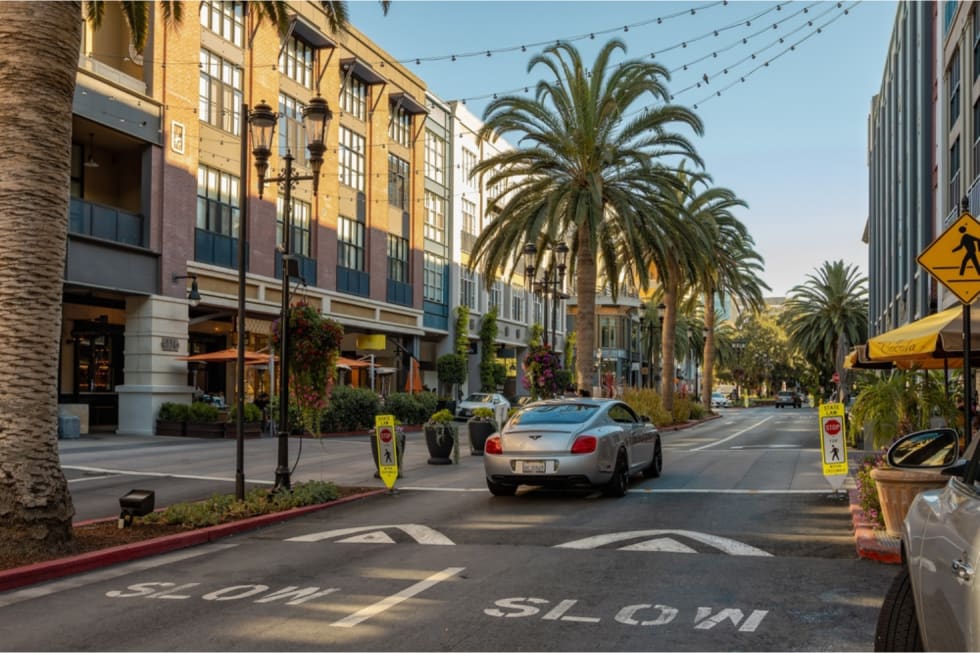
East Virginia flies under the radar and is a hidden gem to renters seeking walkability. Located southeast of Downtown, it offers a strong mix of residential calm and commercial access. The area’s 90 walk score and high bikeability make it easy to access local grocery stores, taquerias, transit stops, and parks without the need for a car.
Its lower transit score reflects the slightly longer walk to light rail or bus stops, but VTA lines still run within range for most commutes. Cyclists benefit from flat terrain and connections to larger bike corridors. If you’re looking for a less touristy but highly functional location to rent, East Virginia delivers well-rounded convenience at a more affordable rate than Downtown.
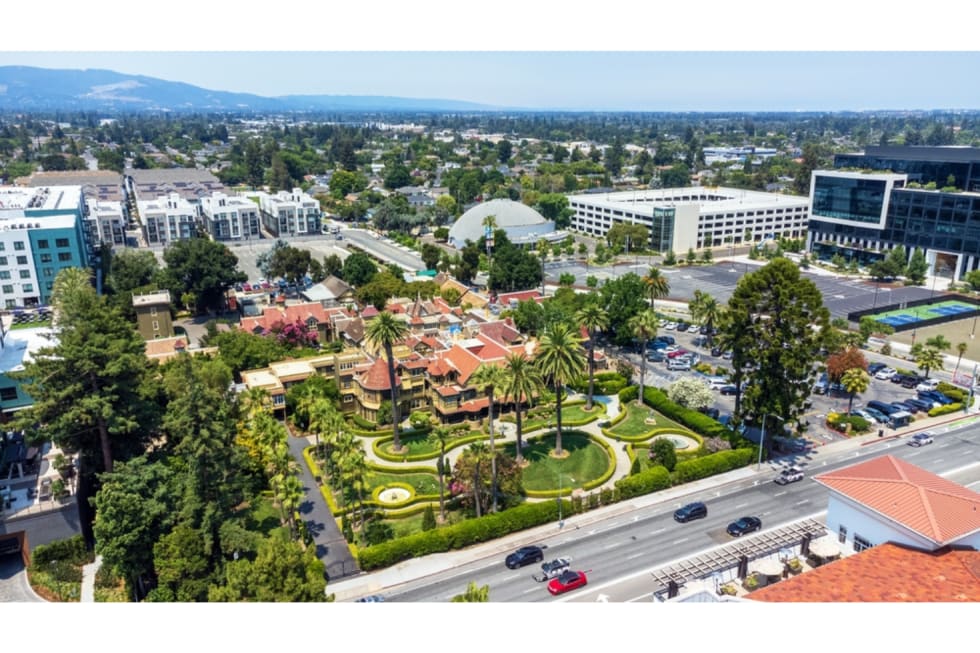
Located between Downtown and the Delmas Park area, Sunol-Midtown blends a laid-back residential feel with excellent walkability. The 87 walk score reflects a strong mix of nearby essentials—think grocery stores, gyms, hardware shops, and cafés—all within a 10-minute walk. Renters appreciate the balance here: more space and quieter streets, but still close to Downtown and transit options.
Access to VTA light rail and Diridon Station makes commuting across the South Bay or into San Francisco realistic, especially for those who work hybrid schedules. The neighborhood has also experienced modest development in recent years, with the addition of new apartment complexes enhancing its appeal. It’s a top choice for those who want bike-friendly streets and wide sidewalks, and it’s also running at the forefront of the pack for renters who want to be close to the action without full-on Downtown rent prices.
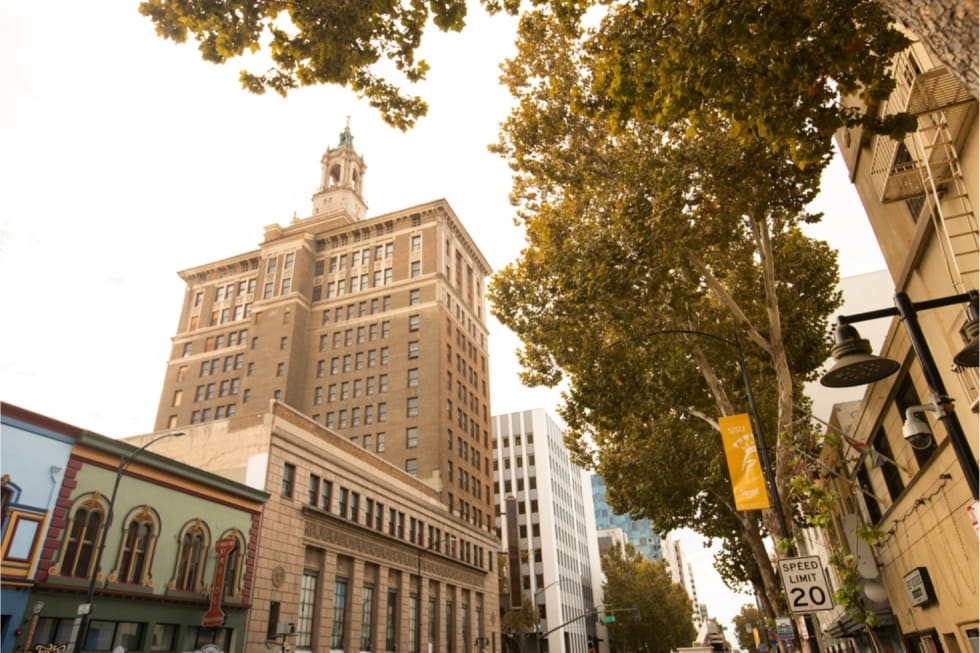
Garden Alameda is a peaceful residential neighborhood tucked between the bustling Alameda Corridor and Downtown San Jose. Its walk score of 83 makes it one of the city’s most walkable residential enclaves, where errands, coffee runs, and weekend dining can all be done on foot. You’ll find a mix of single-family homes and smaller apartment buildings, with nearby parks and shaded sidewalks that invite walking daily.
While the transit score is modest, Diridon Station is just a short bike ride or a 30-minute walk away, connecting renters to Caltrain and VTA services.
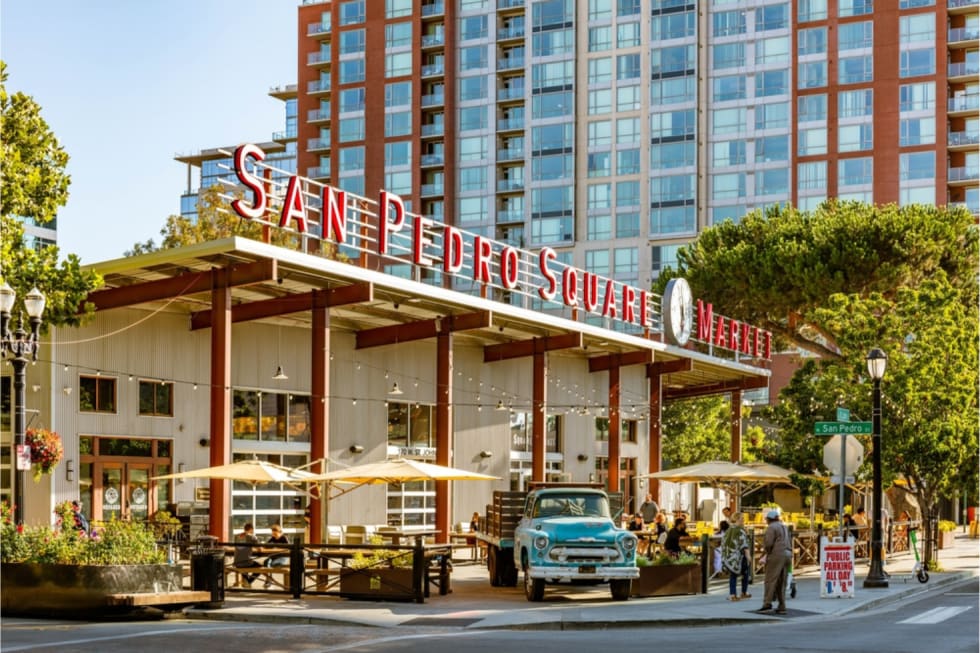
Downtown San Jose is the urban core of the South Bay—and while it doesn’t top the list for walk scores, it’s still one of the most active pedestrian areas in the city. You’ll find easy access to dozens of restaurants, entertainment venues, tech offices, and grocery options, all within a few blocks. For renters seeking nightlife, convenience, and transit in one location, Downtown delivers.
It’s also one of the city’s most bikeable areas, with well-marked lanes and easy rides to the SAP Center, San Jose State University, and Guadalupe River Trail. Light rail and bus lines run frequently through the district, and Diridon Station is centrally located. The dense layout and apartment-heavy blocks make it one of the most logical choices for renters who want everything in reach.
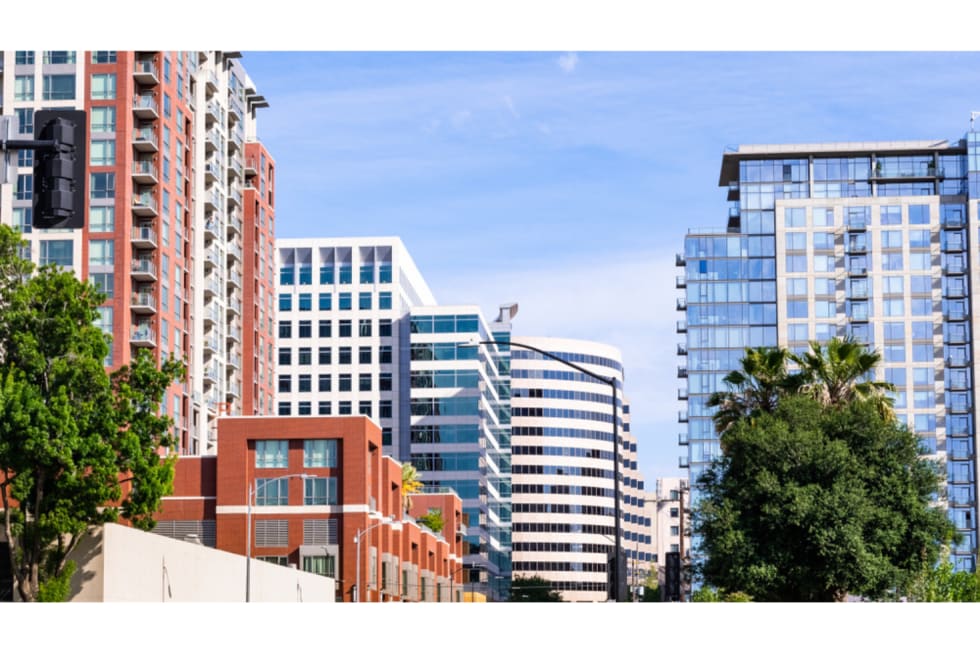
Willow Glen feels more like a small town than a big-city neighborhood. Centered around Lincoln Avenue, it features a cozy commercial district full of boutiques, bakeries, wine bars, and brunch spots—perfect for weekend walks and errands. However, walkability varies depending on where you live. If you’re near the strip, it's very convenient. Further out, driving becomes more necessary.
While Willow Glen has a lower overall walk score, its other redeeming qualities, namely charm and atmosphere, make up for it. The area is a safe bet for renters who want a family-friendly, quiet community with a few car-free conveniences. Its bike and transit options have more limitations, but if you're after charm over connectivity, Willow Glen still holds strong appeal.
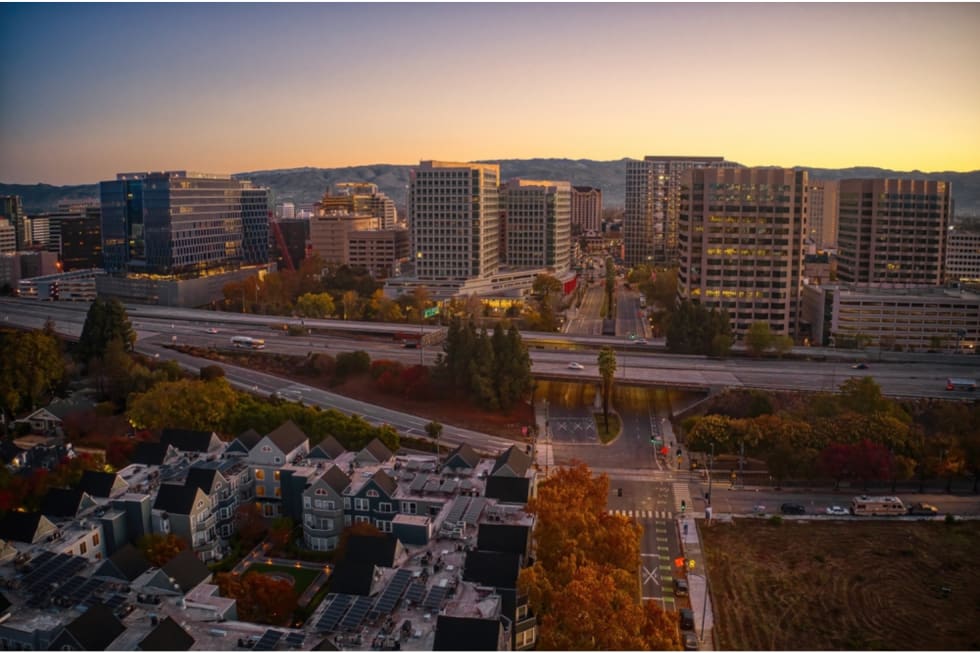
While San Jose isn’t winning any awards for walkability, there are a handful of neighborhoods that make it possible to live there without relying (solely) on a car. In areas like St. Leo’s, East Virginia, and Sunol-Midtown, daily errands, public transportation access, and bike-friendly streets all come together to support a car-light lifestyle.
If you’re looking to avoid traffic, reduce commuting costs, or just enjoy more time outside, San Jose’s walkable pockets are worth considering.
When you're ready to find a place that fits your day-to-day needs, take Apartment List’s quiz and get matched with apartments in neighborhoods where you can actually live the way you want. With Apartment List, you’ll spend five minutes and save 50 hours searching.
St. Leo’s wins the prize as San Jose’s most walkable neighborhood, with a walk score of 92. Situated just west of Downtown San Jose, it has everything you might need—from parks to shops to restaurants—and it's a short bike ride away from other perks like entertainment and major employers.
Yes, you may be able to live in select neighborhoods without a car. Neighborhoods like East Virginia, St. Leo’s, and Downtown San Jose offer walkable streets, bike paths, and access to public transportation, including the VTA light rail and bus lines. In other neighborhoods, a car is needed.
Downtown San Jose offers the strongest overall mix of VTA light rail, bus lines, and regional transit hubs. St. Leo’s and Sunol-Midtown are also solid options for renters who plan to rely on public transportation.
Some parts of the city are. East Virginia and Downtown San Jose have bike scores above 90, thanks to dedicated bike lanes, quiet side streets, and easy access to trails like the Guadalupe River Trail. Infrastructure varies by area, so check local maps before you ride.
It depends on the neighborhood. Downtown and nearby areas like Garden Alameda and Sunol-Midtown have active foot traffic and decent lighting, especially around commercial corridors. As you would in any major city, stay alert, stick to well-lit routes, and check recent neighborhood reviews and crime maps before making a decision.

In unit laundry, Granite counters, Hardwood floors, Dishwasher, Pet friendly, 24hr maintenance + more
In unit laundry, Patio / balcony, Granite counters, Pet friendly, Stainless steel, Walk in closets + more